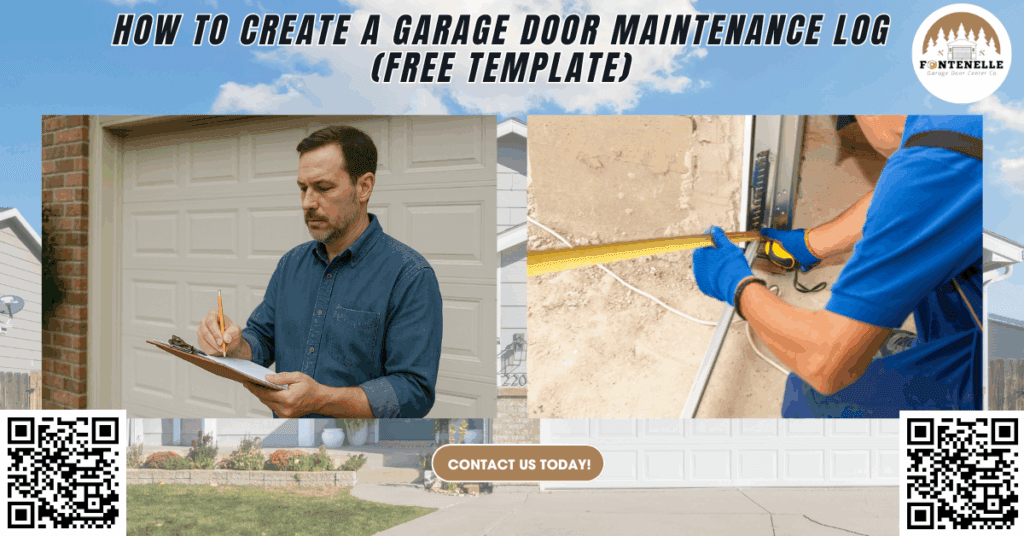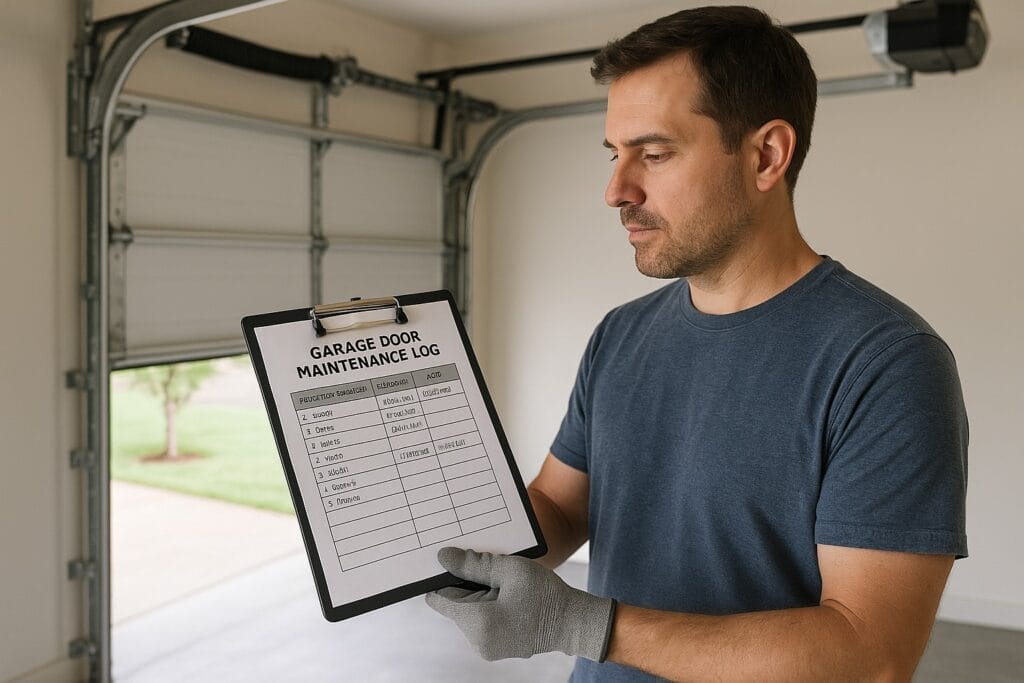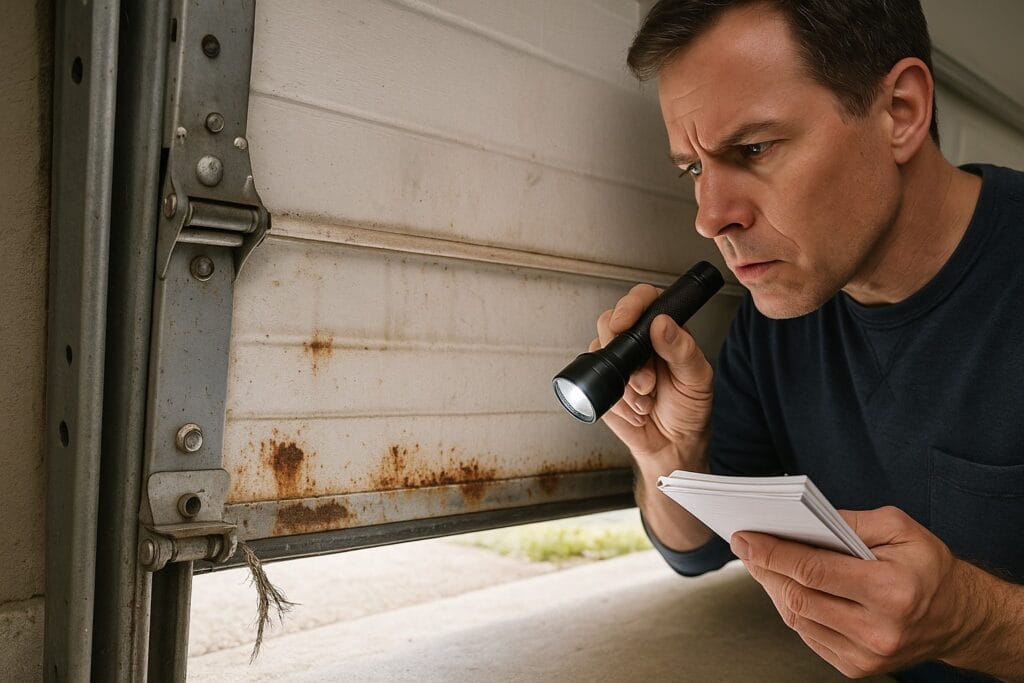How to Create a Garage Door Maintenance Log (Free Template)

A few months ago, a Bellevue homeowner named Tom found himself locked in his garage. The garage door wouldn’t open, and he was late for work. Our technician at Fontenelle Garage Door Center Co. arrived promptly and diagnosed the issue: worn-out torsion springs. Tom admitted he hadn’t inspected or maintained his garage door system in years. This experience is not uncommon, and it highlights the importance of consistent garage door maintenance.
According to recent reports, nearly 70% of garage door failures can be attributed to poor maintenance or neglect. Despite this, regular upkeep is often overlooked by homeowners. A properly maintained garage door can offer smooth operation, extend the life of its moving parts, and increase overall home safety.
At Fontenelle Garage Door Center Co., we specialize in both residential and commercial garage door services in Bellevue, NE, and surrounding areas. We know from experience that even the most robust garage door system can fail without proper care. That’s why we’re excited to share this comprehensive step-by-step guide to help you build and maintain a garage door maintenance log, complete with a free template to get you started.
Why Garage Door Maintenance Matters
Your garage door is one of the most-used doors in your home. Most families open and close their garage door multiple times a day, sometimes up to 1,500 times per year. With frequent use, it’s no surprise that components like springs, rollers, and garage door openers wear down over time. Without regular maintenance, these parts are more prone to failure.
Effective garage door maintenance is not just about ensuring quiet operation or convenience. It impacts:
- Safety: A faulty garage door spring or misaligned track can be dangerous to you and your family. Garage doors can weigh several hundred pounds, and if something fails, it could cause serious injury.
- Longevity: Proper lubrication and part inspections can add years to the life of your garage door system, minimizing the frequency of replacements.
- Efficiency: A well-maintained garage door uses less power, experiences less resistance, and opens and closes more smoothly.
- Cost-effectiveness: Routine maintenance helps prevent costly repairs and emergency service calls by catching small issues early.
When maintenance is neglected, issues like rust spots, corrosion, misaligned tracks, or worn cables and rollers can lead to malfunction. These problems are especially common during extreme weather conditions in places like Bellevue, NE, where cold winters and hot summers take a toll on garage door parts.
What Is a Garage Door Maintenance Log?

A garage door maintenance log is a record-keeping tool used to track all maintenance tasks, inspections, part replacements, and professional services related to your garage door. Think of it as a DIY guide to your garage door’s history.
Whether you’re maintaining wood doors, steel doors, or composite models, a maintenance log allows you to:
- Record dates of inspections and services
- Track garage door parts that have been replaced or repaired, such as springs, cables, or rollers
- Set reminders for upcoming tasks to stay ahead of problems
- Monitor the condition of springs, rollers, tracks, hinges, and other components
- Note any observed damage, debris, or performance changes
- Identify patterns in wear and tear that could inform future maintenance
This log becomes especially valuable for new homeowners, rental properties, or commercial locations that use garage doors multiple times daily. It can also provide crucial documentation when selling your home or making insurance claims.
What to Include in a Garage Door Maintenance Log
Creating a helpful garage door maintenance log starts with knowing what to include. Each section of the log should offer a snapshot of your garage door system’s condition.
1. Date
When was the inspection or service performed? Accurate dates help establish a pattern of maintenance and ensure timely checkups.
2. Task Performed
Be specific. Common entries might include: “Lubricated garage door rollers with **white lithium grease”, “Cleaned garage door tracks with degreaser”, “Tested auto-reverse feature for safety compliance”, or “Replaced garage door opener battery.”
3. Notes
Describe what you observed. Are there rust spots on the track? Any water damage on wood doors? Is the garage door opener making strange noises? Did you notice vibration during operation?
4. Person Responsible
Who completed the task? Was it a family member, a handyman, or a technician from Fontenelle Garage Door Center Co.?
5. Next Maintenance Date
This allows you to create a forward-looking plan to avoid forgetting important tasks.
6. Status
Rate the component’s condition: OK, Monitor, Needs Repair. Consider using color codes (Green, Yellow, Red) to make it more visual.
Keeping these entries consistent ensures that you won’t miss any vital preventative maintenance opportunities.
Essential Maintenance Tasks to Track
Here is a comprehensive list of garage door maintenance tasks that should be logged and repeated based on seasonal and annual cycles:
Task | Frequency |
Lubricate rollers, hinges, springs, top rail | Every 6 months |
Inspect garage door tracks for debris | Quarterly |
Tighten bolts, nuts, and roller brackets | Quarterly |
Test auto-reverse feature and safety sensors | Monthly |
Replace garage door opener batteries | Yearly |
Inspect weatherstripping and seals | Quarterly |
Clean and degrease metal parts | Every 6 months |
Check torsion springs and extension springs | Every 6 months |
Test manual release handle for automatic openers | Annually |
Examine for water damage, corrosion, or cracks | Semi-annually |
Many of these tasks require simple tools such as a socket wrench, spray lubricant, or garage door grease. Use the right lubricant, typically white lithium grease for metal parts, and avoid using WD-40, which can strip necessary oils.
Free Garage Door Maintenance Log Template
Here is a free, printable garage door maintenance log template to help you stay organized:
Date | Task Performed | Notes | Person Responsible | Next Due | Status |
Print multiple copies and keep them in a folder near your garage door opener, or create a digital version using Excel or Google Sheets for easier tracking over time.
Pro Tips to Keep Your Maintenance Log Effective
✅ Store It Where It’s Easy to Access
Attach the log to the wall near your garage door system or upload it to cloud storage so you and others in the household can update it as needed.
✅ Set Automated Reminders
Use Google Calendar or your smartphone to schedule recurring reminders for quarterly or semi-annual maintenance tasks.
✅ Track Repairs With Photos
Take photos of springs, rollers, cables, and other parts that show visible signs of wear. Add them to your digital maintenance log for future reference.
✅ Keep a Record of Parts Used
Note down any part numbers or brands used, especially for items like garage door rollers, weather stripping, or garage door lubricants.
✅ Keep Invoices and Warranty Info Together
Staple or upload any service receipts or warranty documents to your log. This creates a full maintenance history for resale or warranty claims.
Recognizing Signs of Trouble
You should immediately log and investigate the following issues:
- Garage door jerks or hesitates during opening or closing
- Grinding, squealing, or screeching noises from rollers or springs
- Door does not close all the way, or reopen on its own
- Remote control or door opener delays or fails to respond
- Visual signs of rust, corrosion, or water damage
- Loose or misaligned tracks, bolts, or hinges
- Sagging panels or uneven door movement

These are indicators that one or more garage door parts may be nearing failure and should be inspected by a professional.
DIY Maintenance vs. Professional Service
Many garage door maintenance tasks can be performed by a family handyman or homeowner, especially with a reliable step-by-step guide.
Safe DIY Tasks:
- Lubricating metal parts with white lithium grease
- Cleaning tracks using a vacuum or a cloth
- Testing auto-reverse sensors with a paper towel test
- Replacing remote batteries
Tasks That Require Professionals:
- Adjusting or replacing torsion springs or cables
- Diagnosing electrical problems with the garage door opener
- Replacing cracked or damaged panels
- Realigning misaligned tracks or top rails
For anything beyond basic inspection and lubrication, we recommend calling a certified technician from Fontenelle Garage Door Center Co.
Commercial Garage Door Maintenance Logs
For commercial facilities, proper garage door maintenance is not just recommended, it’s often legally required for safety compliance.
Suggested logging frequency for commercial applications:
- Daily: Visual inspection for door alignment, debris, or obstruction
- Weekly: Check for unusual noises, signs of wear, and test door operation
- Monthly: Test safety features, including auto-reverse and release handle
- Quarterly: Schedule a professional technician inspection
Detailed logs protect your company from liability, minimize operational downtime, and help ensure safe, efficient access to facilities.
Seasonal Tips for Bellevue, NE Homeowners
Winter
- Inspect and replace brittle weatherstripping
- Lubricate metal parts to prevent freezing
- Keep garage door tracks clear of ice and snow
Spring
- Clean off road salt and grime from rollers, hinges, and bottom seals
- Inspect for water damage and mold on wooden garage doors
Summer
- Check for insects nesting inside garage door openers or tracks
- Inspect insulation and seals to keep the garage temperature regulated
Fall
- Clean garage door tracks of fallen leaves and dust
- Schedule a complete system tune-up with Fontenelle Garage Door Center Co.
Final Thoughts
Maintaining your garage door doesn’t have to be complicated. With a little organization and the help of a garage door maintenance log, you can prevent common issues, extend the lifespan of your system, and ensure the safety and convenience of everyone in your home. Whether you’re dealing with springs, rollers, cables, or openers, staying on top of regular maintenance is always the smartest move.
Remember, a small investment of time and care can save you significant money and stress down the road. Use our free template to start tracking your maintenance today, and enjoy the peace of mind that comes with knowing your garage door is in top condition.
How Can Fontenelle Garage Door Center Co. Help You?
At Fontenelle Garage Door Center Co., we understand how essential a well-functioning garage door is for your home or business. Located at 1001 Fort Crook Rd N, Bellevue, NE 68005, our experienced technicians are trained to handle every aspect of garage door maintenance, from torsion springs and rollers to full garage door opener replacements.
We proudly offer:
- Scheduled preventative maintenance
- Emergency garage door repair services
- Custom installation and replacement
- Safety inspections and part replacements
- Personalized maintenance logging assistance
📞 Call us today at (402) 674-4281 to schedule your next maintenance check or service. Whether it’s your first inspection or your annual tune-up, Fontenelle Garage Door Center Co. is your trusted partner for reliable, local service.
Let us help you keep your garage door in top condition, year after year.
Frequently Asked Questions (FAQs)
1. How long does a typical garage door last with proper maintenance?
A well-maintained garage door can last between 15 to 30 years, depending on material, usage, and environmental conditions.
2. What is the best time of year to perform garage door maintenance?
Spring and fall are ideal, as the weather is moderate and you can prepare for extreme temperatures.
3. Can I use WD-40 instead of white lithium grease on my garage door?
WD-40 is not recommended for garage doors because it is a solvent, not a lubricant; it can strip away needed grease.
4. How can I tell if my torsion spring is about to fail?
Signs include a visibly stretched spring, difficulty opening the door, or a loud bang from the garage.
